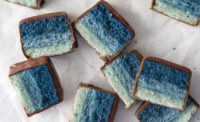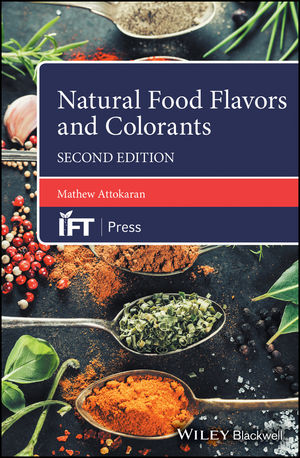Bold sensory explorations








The combination of flavors and colors can elevate snacks and select baked goods into experiences—impactful moments in edible time that build brand loyalty and drive repeat purchase. While subtle and traditional flavor and color approaches still maintain their core audiences, bold, ethnic and otherwise adventuresome approaches continue to gain more favor.
Flavor tripping
Vacation season may be over for a few months, but there’s an easy way to take a quick and inexpensive vacation: snacks. “Consumers look to snacks to provide a mini vacation from their daily routine,” says Joni Ford, senior advertising and promotions manager, Kalsec, Kalamazoo, MI. “Snacks provide an escape through unique flavors and colors. There are limitless combinations for adding value to existing conventional snack products.”
And, according to Patrick Laughlin, director of marketing, Fuchs North America, Owings Mills, MD, people today are more open to unique flavors: “The world is more connected thanks to the Internet, and people travel more. At the same time, novel ingredients are easier to find, and people are cooking more and experimenting with new flavors.”

This gives snack producers and bakers more opportunity to go exotic and specialized. “Consumers’ palates are evolving,” says Devon Edmonson, marketing and advertising coordinator, Mother Murphy’s, Greensboro, NC. “More consumers than ever consider themselves adventurous and open to trying new flavors. There is definitely a demand for more ethnic, exotic and lesser-known regional flavors.”
A primary driver of all this experimentation is the millennials. Ever the variety-seekers, millennials are on a constant hunt for the next mini vacation courtesy of their favorite snack. And the types of flavors most popular among these consumers? Exotic. Spicy. Bold. Seasonal. Fusion. Ethnic.
“I see consumers looking for a pairing of ethnic and spicy flavors in a new combination that offers heat and a brisk note called ‘sweet heat,’” says Edmonson. “Additionally, having contrasting flavors is a great way to satisfy consumer demand for multiple experiences from a single snack product. Consumers want bold and spicy flavors with depth and complexity.”
More snack manufacturers continue to experiment with heat. “In salty snacks, cheese is still the biggest snack flavor but tending down, while spicy continues to be hugely popular and growing rapidly,” says Paula LaBine, business development director, Kerry Ingredients, St. Louis. She suggests spicy fusion flavors like sweet Thai chili and chipotle lime as the complex fusion flavors consumers today like.
Kim Holman, director of marketing, Wixon, St. Francis, WI, cites the new Frito-Lay Doritos Roulette as a product that harnesses unbridled bold heat in an interesting way. “This is a clever, interactive experience for the consumer,” she says. “Every third chip in the bag is super spicy, so you never know what you are going to get in your mouth, because all the chips look the same. This gives consumers a memorable experience with a brand.”
Holman notes that she has been seeing a trend toward Hispanic and Pan-Asian flavors. “Snacking is going to reflect population trends,” she says, “and the Hispanic population group is the fastest-growing population in the U.S. Manufacturers will want to capitalize on the taste preferences of this group. Regarding Pan-Asian, profiles we have seen include flavors of nori, ginger and kimchi, to name a few.”
Ginger brings multidimensional cachet to the flavor mix. “Ginger drives all types of flavor innovations, because it provides two types of heat—one that’s refreshing and one that’s spicy,” says Edmonson. “And there is a healthful halo around ginger.,”

Seasonal and limited-time-offer (LTO) flavors can also find strong resonance with shoppers. “Millennials seeking variety have resulted in the launch of many seasonal flavors, such as mocha, eggnog, caramel sea salt, red velvet and chai white chocolate, into snacks,” says Denise Radke, marketing manager, QualiTech, Chaska, MN.
Nostalgic, childhood-oriented flavors are also trending well. “We are seeing favorites such as cotton candy, bubble gum, root beer, s’mores and birthday cake,” says Radke. She suggests customized approaches to build a distinct profile. “We can also go one more step with inclusions, providing a flavor burst or complementary texture a consumer may not be expecting.”
Laughlin notes that market research points to flavor profiles like smoky, grilled, fermented, complex spicy, honey, citrus, pickled, roasted and toasted as on a growth trend. Of course, delivering on these desired profiles can be a bit of a challenge. Consider the pickled profile. “It can be hard for that tartness to come through on a potato chip,” he says.
Joe Leslie, national industrial sales manager, Kikkoman Sales USA, Inc., Chicago, observes that soy sauce and soy sauce powders are “finding their way into a diverse mix of snack and bakery products. Soy sauce gives a great umami kick, in addition to adding richness and balance. It is a great behind-the-scenes ingredient to bring out the desired flavor.” He notes that such ingredients typically do not provide the main flavor, “but help by boosting flavor and providing balance.”
In order to gain sweet complexity in fusion and exotic combinations, some manufacturers are turning to honey. Not only does honey provide appealing flavor to products, “consumers have a positive perception of honey, giving manufacturers a benefit beyond flavor,” says Catherine Barry, director of marketing, National Honey Board, Firestone, CO. “And because honey flavor profiles are influenced by the flower source where the bees gather the nectar, honey can deliver more than 300 unique flavor profiles.”
Barry notes two products of interest that use honey: KIND Honey Smoked Barbecue bars and Honey Mustard bars—sweet-savory-salty snack bars that act as a sort of replacement for potato chips.
Delivering flavor along with salt can build interest. Petra Varney, director of marketing, SaltWorks, Woodinville, WA, notes that a new line of sea salts, with more than 25 varieties, combines all-natural sea salt with an additional ingredient, and is ideally suited to topical snack applications for a pop of texture, color and flavor. She suggests Black Truffle Sea Salt for popcorn or french fries. Other options include Jalapeño Sea Salt and Espresso Brava Sea Salt, a fusion of roasted espresso beans that “captures the heart, body and crema of espresso,” she says. All the salts are produced naturally, without chemical refining or additives, and retain their trace minerals.
“I recommend that our customers focus on a profile when formulating their next new product,” says Laughlin, “and not a specific flavor. Single flavors can come and go, but profiles will be around for a while.”
LaBine gives one such example: sriracha. While she notes that some customers now consider sriracha “last year’s flavor,” other profiles are rising. “Newer pepper flavors are ghost pepper, gochujang and harissa,” she says. “These can provide a new and exciting point of difference.” Korean gochujang combines heat from red chiles with a fermented note, while North African harissa offers complexity via spicy roasted chiles, toasted spices like coriander and cumin, and a notable hit of garlic.

Color your world
An often-cited foodie axiom is that we eat with our eyes. So the delivery of the right flavor must find support from the right color. Katie Queen, associate application scientist, DDW The Colour House, Louisville, KY, notes that many customers want bold colors to match exotic flavors in their foods, such as deep red with sriracha.
Shoppers today also desire clean-label options. Like the broader ingredients industry, the color industry has been witnessing the shift to natural.
“The big trend in colors over the past few years is the switch from artificial to natural colors, spurred by the 2007 Southampton study,” says Tracy Takeda, product development technologist, San Joaquin Valley Concentrates, Fresno, CA. The Southampton study drew a link between consumption of certain artificial colors and sodium benzoate and increased hyperactivity in some children. While the study had its detractors, it has spurred an undeniable shift in the industry. European food manufacturers, in particular, moved quickly to natural colors, and by 2011, 85 percent of new products flagged natural colors. By 2011, global sales of natural colors had surpassed synthetic colors (“New research reveals natural colours overtake artificial/synthetic colours for first time,” Mintel and Leatherhead Food Research, February 2013).
Aside from a growing concern about the effect of artificial colors on small children, there has lately been a broader movement to eliminate artificial colors and flavors across the board for many categories. In a recent study by Sensient Colors, 66 percent of all consumers expressed concern over artificial colors, and that percentage rises to 72 percent among millennials and 86 percent among millennial moms (“Millennial moms are driving the simple ingredient trend,” January 2015, Sensient Colors/KRC Research).
Of course, color providers have responded to the growing demand for natural colors. Takeda comments that improvements and expansions along these lines include development of colors from natural sources to provide natural alternatives to red colors from insect sources like carmine or cochineal, which have seen some negative response from vegans and vegetarians, among others.
“We have a unique form of colors from natural sources,” says Takeda, “crystal colors that are made on a patented dryer without the use of carriers. These colors are more easily soluble than spray-dried colors, are more concentrated in color than liquid colors and have negligible calories.”
Ford notes that color stabilization technology helps ensure bright, vibrant colors. She says a recently expanded line of high-stability red colors remain stable through a variety of processing conditions.
Achieving boldness in colors can pose challenges—but advances have been made. “Anthocyanins are typically used in acidic applications, like beverages, to provide a red color,” says Takeda. “However, some snack companies have found innovative ways to use anthocyanins in higher-pH applications for a purple-blue color. They have been known to be used in tortilla chips to enhance or create a blue color appearance.”
Caramelized fruits and vegetables can offer simple label options for brown color shades. According to Queen, “Our ingredients include sources such as onion, garlic, pumpkin, tomato, apple, pear and mirepoix.” These can simply be labeled as “caramelized (fruit or vegetable)” or “cooked (fruit or vegetable).” For an LTO or seasonal fall product, she suggests caramelized pumpkin to provide color for pumpkin breads or pumpkin- flavored snack coatings.
Other options include oil technology products that create a “rainbow of oil-dispersible colors,” Queen notes, without the use of emulsifiers. “With this technology, our customers can evenly coat sugars and salts for bakery and snack toppings in a wide range of colors.”
With such options at their fingertips, snack producers and bakeries have the opportunity to create quite a delicious edible rainbow of offerings.

Looking for a reprint of this article?
From high-res PDFs to custom plaques, order your copy today!











